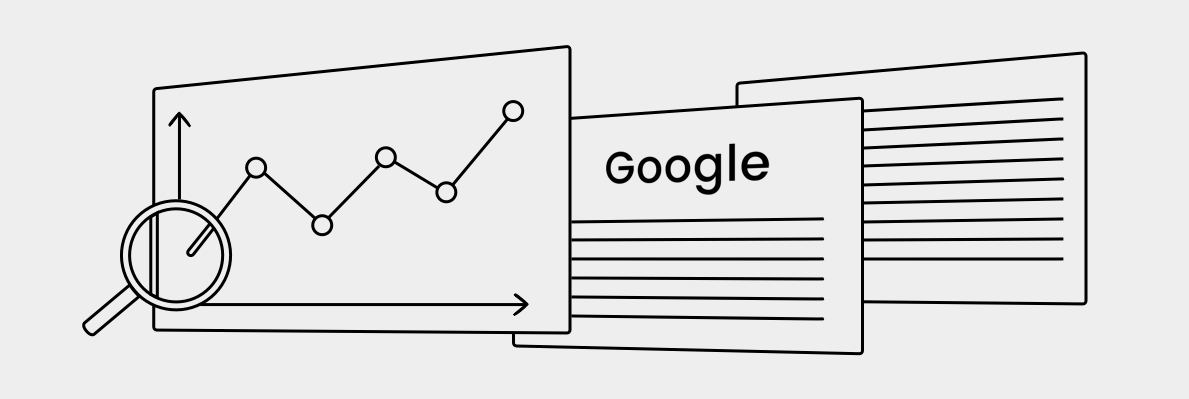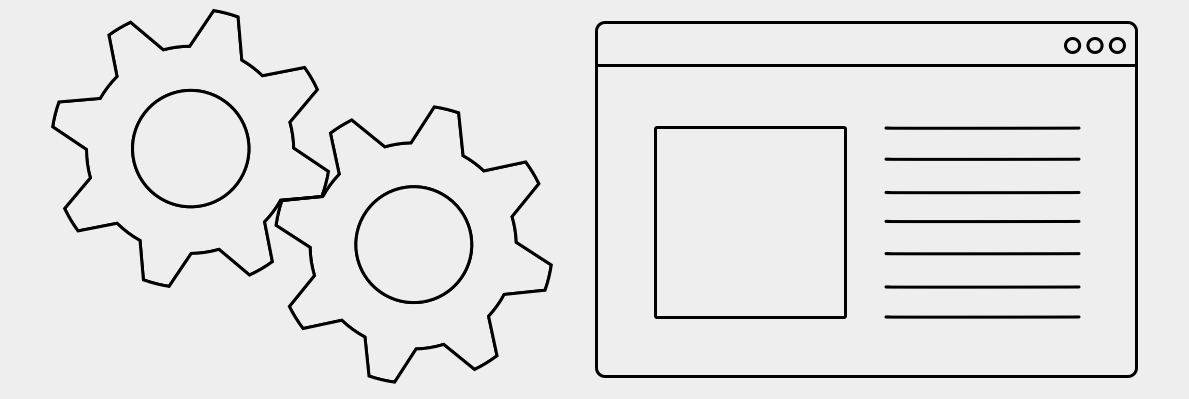In this guide, we’ll be covering the core areas we focus on during an SEO audit, and their importance to your online growth.

Site structure & crawlability
The way your website is structured can have an impact on how often Google visits your pages, and how important it deems them to be.
Google’s crawler, Googlebot, visits sites to take stock of what content lives there, and how these pages are connected to other pages. Pages deep in the site hierarchy, and pages that aren’t linked to frequently on-site, tend to be visited less frequently. Issues with site structure and crawlability can prevent your content being found, or cause it to appear lower down in the search results than you would like.
Areas we investigate
Site indexation
How many pages has Google indexed on your site? Does this tally up to the number of pages that are actually there? If Google’s number is lower, then it’s likely having trouble crawling your site. If Google’s number is higher, then it’s indexing things it shouldn’t be — which points to a pagination or duplication issue.
Proper faceted navigation
Faceted navigation — allowing users to filter products by colour, price range or size — can improve user experience, but it’s not always good for search engines as it can create hundreds of versions of the same page. This leads to indexing problems and harms the ranking of the primary category page that you actually want to appear in the search results. Luckily, this is easily fixed by adding canonical tags that tell search engines which version of the results is the main one.
Pagination
If you have a blog or product category that has multiple pages (e.g. page 1, page 2…) it’s important to make sure search engines recognise them as a whole, rather than seeing each one as an entirely different page. We can do this by setting up relevant canonical links.
Hreflang attributes
Hreflang tags are used when a page exists in multiple languages, and lets search engines know where to find the other language versions of each page. If you have an international or multi-language site, this is definitely something worth checking for, and will help ensure that correct content is served in the correct format.
Mobile
With the mobile-first index now live, it’s very important to have the same content available on mobile as on desktop. If you have a responsive site, this isn’t so much of an issue, but those with a separate ‘m dot’ site (e.g. m.example.com) could be losing out on a lot of search traffic if the content is different or tagged up incorrectly (e.g. missing rel=alternate and rel=canonical links).
Server log analysis
Which pages are being crawled by Googlebot, and how often? By investigating your server logs, we can identify any issues with how Google is crawling a website and make appropriate fixes to ensure that the site is being crawled efficiently.

Server Issues
Server issues can cause all kinds of problems that affect site speed, security, site availability and more. These don’t just affect your rankings — they can also test users’ patience with your site, harming the trust they have in your brand and making them less likely to use your services.
Making changes at server level can reduce the number of errors in Search Console, improve site performance, and ultimately boost user experience and search rankings.
Areas we investigate
Multiple site versions
To a search engine, each of the following is a different site — even though the content is the same:
- http://www.example.com
- http://example.com
- https://www.example.com
- https://example.com
To prevent site duplication, and to avoid spreading backlinks across four versions of your site, we must ensure that all other versions redirect to the primary one. Whether you include the www is up to you, but if you have an SSL certificate (which you should), pick a version with https before it.
URL capitalisation
Likewise, http://www.example.com/PaGe should redirect to http://www.example.com/page. Ensuring that any upper-case characters resolve to a lower-case version ensures the page doesn’t become duplicated if people link to it in a different case.
URL trailing slashes
This is similar to URL capitalisation, but refers to whether the URLs end with a / or without. It's a matter of personal preference, but it pays to be consistent. We can do this by redirecting all pages without a trailing slash to their equivalent with, and ensuring all on-site links adhere to the same conventions.
Server response codes
The server response code that most people are familiar with is the 404, which means the page cannot be found. This is just one of many, but our goal here is to ensure that the majority of pages return a 200 response code (which means everything is OK).
While having some permanent redirects (301s) can be healthy, temporary redirects (302s) can be a cause for concern, and if the server consistently returns 500 errors (timeouts) then that’s usually indicative of a serious issue.
If you have too many server errors, search engines assume your site isn’t maintained properly, or is broken in some way. This can harm your search performance if it persists.
Site speed
53% of mobile users abandon a site if it takes longer than 3 seconds to load. Slower page response times lead to higher abandonment rate, and this can really affect your bottom line.
A slow site also hinders search engine crawlers. Googlebot sees a fast site as a sign of healthy servers, and on the flip side, sees a slow site with timeout errors as proof of the opposite.
Secure HTTPS
An SSL certificate, which gives you the green padlock or URL beginning with HTTPS, provides a secure connection between a user's web browser and a website.
Secure connections were traditionally used only to protect highly confidential transactions like online banking and online shopping order forms, however, with encouragement from major search engines, they’re quickly becoming the norm for all websites. Some browsers now display warning messages on non-secure websites, which can harm trust and conversion rate.
SSL is now a key ranking factor for Google, indeed Google will now mark your site as “unsafe” if it is not secure. So having a non-secure site will harm your rankings and CTR.
Content
Typically, we perform content audits separately. These tend to focus on how existing content can be improved to appeal to your audience and help achieve your objectives.
However, it’s also important to look at content from an SEO point of view. This is an area that can really improve your search rankings, help you track your search performance, and bring new visitors to your website.
Areas we investigate
Keyword cannibalisation
When multiple pages on your website are targeting the same keyword, they can end up competing against each other to rank. In some cases, this leads to several pages ranking poorly for the same keyword, rather than one page ranking well. By mapping keywords to the correct pages, we can ensure that only the most valuable page is optimised for a targeted term.
Broken pages
Linking to broken pages harms user experience, making your site more difficult to navigate. By identifying broken pages, we can begin to either remove or update the links, pruning your site of dead content and providing a more positive ranking signal to search engines.
Optimising internal search
Does your site have an internal search function? How well does it work? Optimising this on eCommerce sites can have a powerful impact on average basket value, and analysing internal search queries in Google Analytics can help you identify new content opportunities based on what your users are looking for.
Optimised internal anchor text
Descriptive internal anchor text can help search engines contextually understand what your content is about. For example, you might want to link to a page about energy-saving light bulbs with the anchor text ‘energy-saving bulbs’, rather than ‘click here’.
Optimised title tags
Title tags should be short enough that they aren’t truncated by search engines, and long enough to accurately describe the contents of a page. It’s good practice to include keywords where relevant, and remember: your title tag, along with your meta description, is ultimately what will make people decide to click on your page from the search results. So, make it count.
Duplicate titles
Using the same title for multiple pages can cause them to compete for the same term, as well as making it more difficult for users to navigate your site if they have multiple tabs open.
Header 1/2/3 tags
Header tags help search engines understand the hierarchy of your page’s content. Including keywords in these, where relevant, can also help with rankings.
Image alt tags
An alt attribute is a short description of an image, designed to be displayed in situations where the image cannot (e.g. if somebody is using a screen reader). They can also help your images appear for relevant Google Images searches, and for some sites, this can be a great untapped source of traffic.
Content quality
Low-quality content can seriously impact your rankings, and it’s also a conversion killer. Content should be valuable, relevant, and easy to crawl.
If we identify issues in this area, then it’s likely you would benefit from a full content audit. This would involve taking both a qualitative and quantitative look at all content on your site, identifying patterns (e.g. knowledge level is too high for the intended audience on 67% of pages) and one-off issues (e.g. page X has too many calls to action). After a full content audit, you’ll receive a report and a plan of action that we can work on over the following months.
Optimised meta descriptions
While meta descriptions aren’t a ranking factor, they are key to increasing your click-through rate from organic search. A well formatted, unique meta description will likely increase your overall click through rate, driving additional traffic and conversions through your site.
Outbound links
Outbound links are links from your site to other domains. There’s nothing wrong with contextual outbound links, but having too many can cause issues.

External & CMS-specific
As part of our audit, we’ll also look at external factors such as Search Console errors, data highlighting and XML sitemap submission. This helps us to ensure that Google is seeing your site the way you want it to be seen.
Areas we investigate
Google Search Console
Is your site set up in Google Search Console? Are there any manual webspam actions, or crawl errors, or problems with your sitemap? If so, we’ll order them by priority and get them fixed.
Data highlighting
Google’s Data Highlighter tool is an easy way to implement structured data on your website. This is particularly useful for sites that have set page templates, like product pages, blog articles or event listings. This data can then filter through as rich snippets in the search results, so data like event date, star review or article author can show in the SERPs.
CMS specific
If you’re using WordPress, for example, we’ll want to make sure that you’re not accumulating too many blog tags, and ensure that there aren’t any plugin clashes. Plugins such as Yoast could be overriding the page title rules you’ve set somewhere else, or it might be creating sitemaps for areas that don’t need them.

Backlinks
Backlinks act as votes of confidence from other websites to your own, and are still Google’s most important ranking factor. However, not all backlinks are good: backlinks from low-quality, spammy websites can actually harm your rankings.
By auditing your backlinks we can identify good links, problematic links, and any gaps in your backlink profile that you might want to address in order to make it appear healthier and more natural. For example, if all your links are from ‘useful link’ sections, we’d suggest diversifying this with some high-quality editorial and PR-based links.
Before we undertake any link-building activity, it’s important to make sure we’re not building on bad foundations. To find out more about what backlinks are and why they matter, see: The Value of a Link
Analytics and tracking
Accurate Google Analytics implementation is crucial to learning how your users are interacting with your site and proving the ROI of your digital marketing efforts. We'll review your setup and check the data for any issues — high bounce rate, or low time on site, for example.
Areas we investigate
Goal tracking recommendation
Google Analytics goals allows us to understand how frequently users are performing desired actions, and where these users come from. If you’d like to know how many people from your email list go on to download the whitepaper on your website, or how many people fill out your contact form from organic search, solid goal tracking is essential.
Review of existing setup
Is your office IP excluded? Is referral spam, or ghost referral spam, falsely inflating your numbers? We’ll run through your Google Analytics setup to ensure everything is accurate and working as it should be. This allows us to more effectively track the success of your campaigns, and prove ROI.
An SEO audit is a great way to take stock of how your website is performing from a search point of view. It allows you to identify areas for improvement, and resolve issues that are stopping you from ranking as well as you could be. As higher rankings mean more traffic, and more traffic means more revenue, an SEO audit is an essential starting point for any online marketing campaign.
Want to find out more about how SEO can help your business? Read more about our SEO services or get in touch for a chat.


